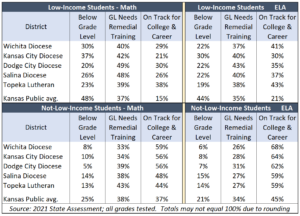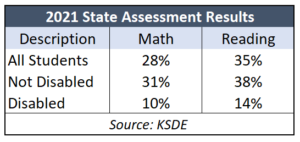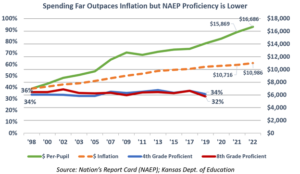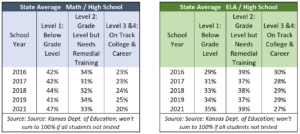The recent report from the Kansas Association of School Boards (KASB) on K-12 student assessment entitled Understanding State Assessment Data is rife with rationalizations, excuses, and irrelevant information to excuse low student achievement. That’s the conclusion of David Dorsey, Senior Education Policy Fellow at the Sentinel’s parent company, Kansas Policy Institute, in a critique of the study.
Dorsey dissects the study to reveal “Five Myths” in the KASB report:
Myth #1. Having higher standards than most states accounts for lower proficiency on state assessments.
KASB says Kansas has the highest standards, based on a U. S. Department of Education study mapping state standards against the National Assessment of Education Progress (NAEP) definitions for proficiency. First of all, that’s a bit misleading. The Kansas proficiency standard for 4th-grade Reading is only considered Basic on the NAEP and ranked #15 in the nation. 4th-grade Math is tied for third place and equates to proficiency, and Kansas has the highest state proficiency standards for 8th-grade Reading and Math.
Here is the implication of the NAEP mapping study in a practical example, according to Dave Trabert, CEO of Kansas Policy Institute.
“In 2019, the state assessment showed that 29% of eighth-grade students were proficient in English language arts, and the 2019 NAEP results showed that 32% of Kansas eighth-grade students were proficient in reading. So since Kansas has a higher bar for proficiency in this measurement, it’s fair to say that the state assessment result of 29% is likely at or a little above 32% from a national perspective. But that doesn’t explain away the results. Whether 29% or 32%, the proficiency rate is still very low.”
Dorsey contends that lauding the state for having high standards while ignoring declining student achievement is akin to a perennially mediocre team being praised for its yearly goal of winning a championship.
Myth #2. Public school assessment scores are similar to those of private schools when all variables are considered.
One of KASB’s favorite tricks is making claims based on selective, partial information and passing them off as comprehensive analyses. They do that here to pretend that public schools and private schools have similar results.
An apples-to-apples comparison shows private schools have superior outcomes for low-income students as well as those who are not low-income. The state does not publish an average for all private schools, but each large grouping of private schools that take the state assessment outperforms the state average for public schools.
 Only 15% of low-income students in public school are on track for college and career (proficient) in math, whereas the range for Catholic and Lutheran schools goes from 21% to 38% proficient. Just 21% of public school low-income kids are proficient in English Language Arts, but the private school range goes from 30% to 43%.
Only 15% of low-income students in public school are on track for college and career (proficient) in math, whereas the range for Catholic and Lutheran schools goes from 21% to 38% proficient. Just 21% of public school low-income kids are proficient in English Language Arts, but the private school range goes from 30% to 43%.
Similar disparities exist for students who are not low-income.
Myth #3. Public school assessment scores would be higher if not for a growing number of special needs students.
KASB provides no data to support its contention, but even to the extent true, the non-disabled students still have very low proficiency levels on the state assessment.
 Among non-disabled students, only 31% are proficient in Math and just 38% in English Language Arts. Those results are a little better than for all students (28% and 35%, respectively) but by no means are those good results.
Among non-disabled students, only 31% are proficient in Math and just 38% in English Language Arts. Those results are a little better than for all students (28% and 35%, respectively) but by no means are those good results.
Dorsey also notes that public schools get hundreds of millions of dollars in aid for at-risk students, English Language Learners (ELL), and special education students, which is almost entirely unavailable to private schools. He also points to state audit results showing most of the at-risk spending examined was not spent for the direct benefit of those students as required by state law.
Myth #4. Assessment scores would be higher if not for state budget reductions to K-12.
First, there is no evidence that spending more money translates to better achievement; that’s another myth perpetrated by KASB. Indeed, the evidence shows no relationship between spending and achievement. Spending per student has been steadily increasing since 1998, but achievement remains flat and low.

ACT scores showed some improvement in college readiness but peaked in 2015 and have dropped precipitously since then. Only 21% of Kansas graduates were college-ready last year in English, Reading, Math, and Science.

Myth #5. Assessment scores are comparable to the increasing amount of post-secondary success.
KASB contends that public schools must be doing their job well if more people are attending college or post-secondary training, but Dorsey says that’s another attempt to deflect and distract. ‘Butts in college seats’ is not a proxy for academically preparing students for college and career.

There have been more high school students below grade level than on track for college and career (proficient) since 2017. KASB and the public school system neither admit to that sad fact nor attempt to do anything about it. Instead, they try to cover up poor performance and offer weak excuses to make themselves look better,
Dorsey offers his conclusion to his review of the KASB study:
But the time for excuses is long past over. The time now is for action. The real reason state assessments are so low has nothing to do with funding or low-income students or standards. It’s simply a matter of will, or maybe ‘won’t’ is a better word. Instead of making student achievement a priority, the State Board of Education and KSDE have downplayed state assessments since the end of No Child Left Behind. In its place, the emphasis is on the pillars of the Kansans Can initiative, one that focuses on institution-based inputs to the system at the expense of student outcomes. Since that initiative is going in the wrong direction, it’s time the Legislature allows parents to take a different direction. Then, just maybe, the education establishment would attend more to student performance, and KASB wouldn’t have to fish for excuses.”



